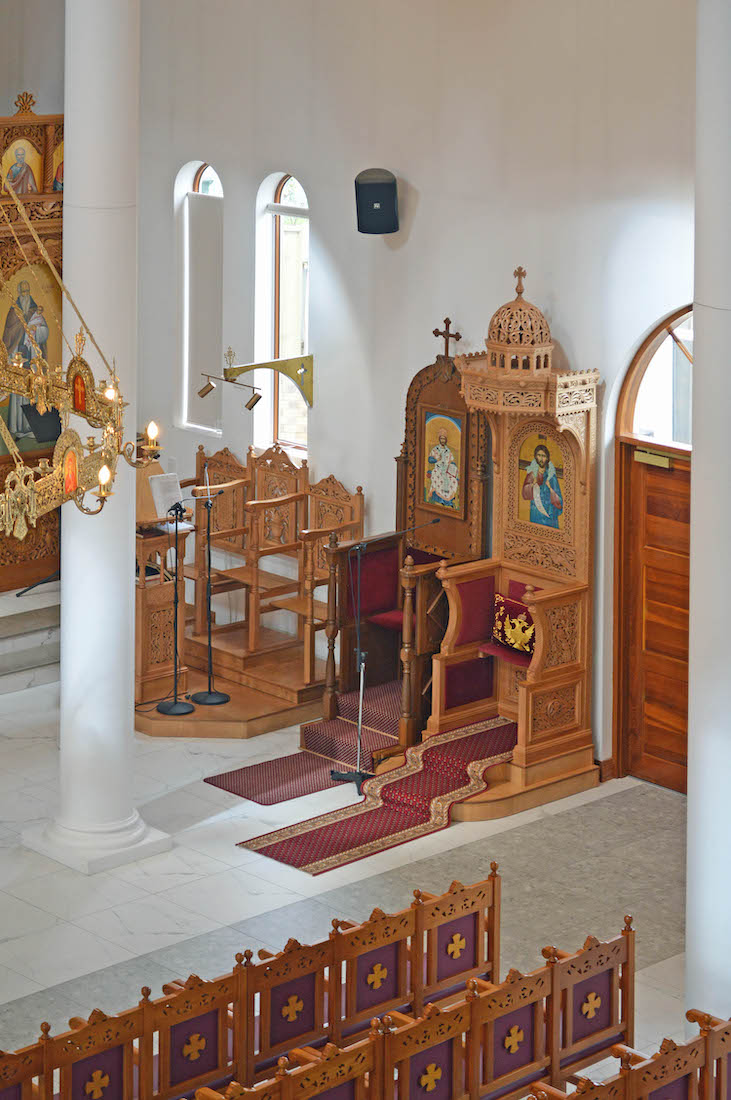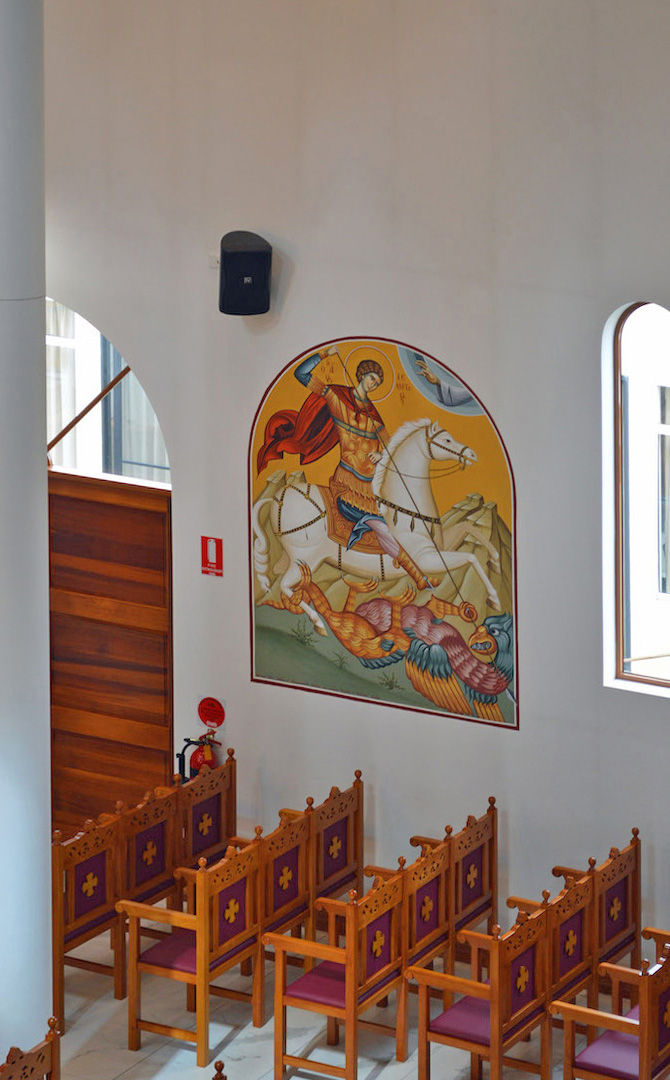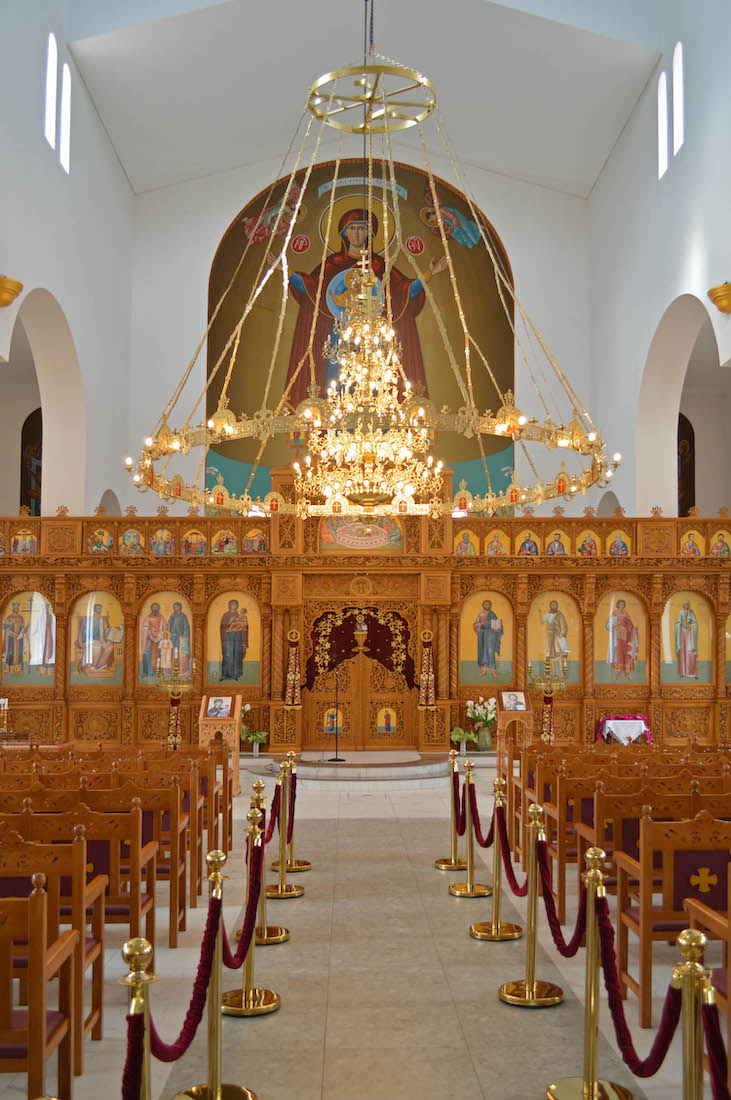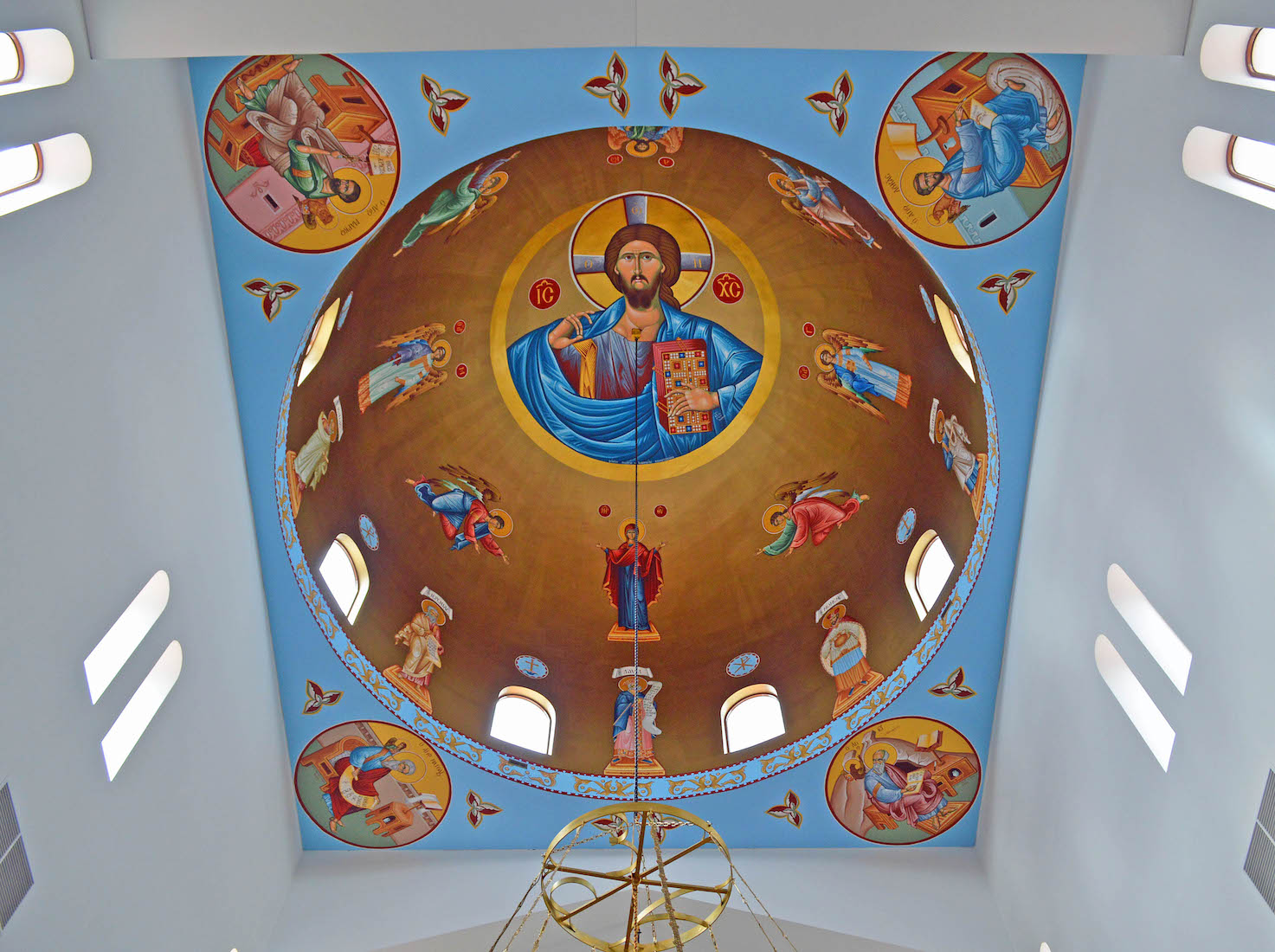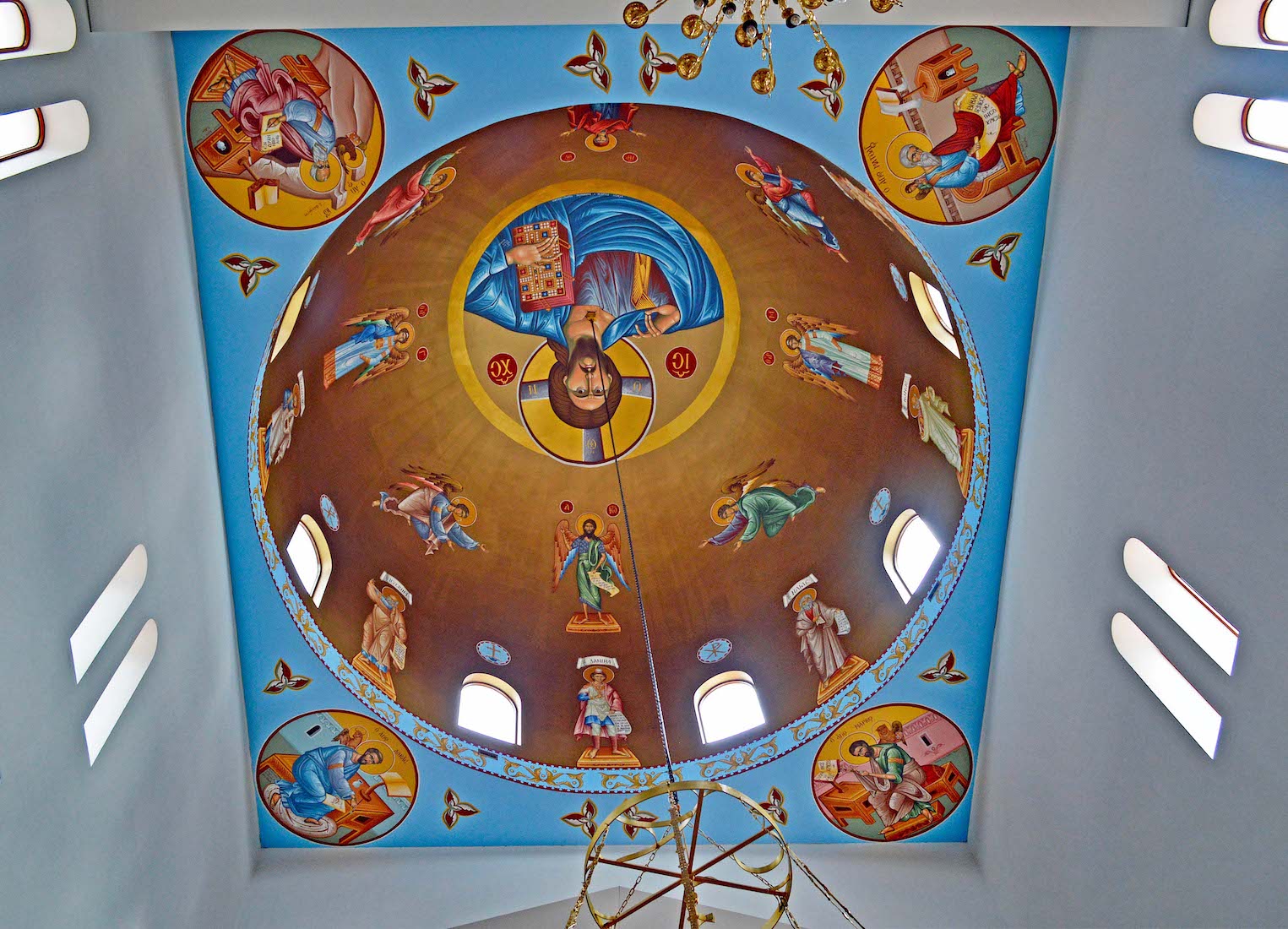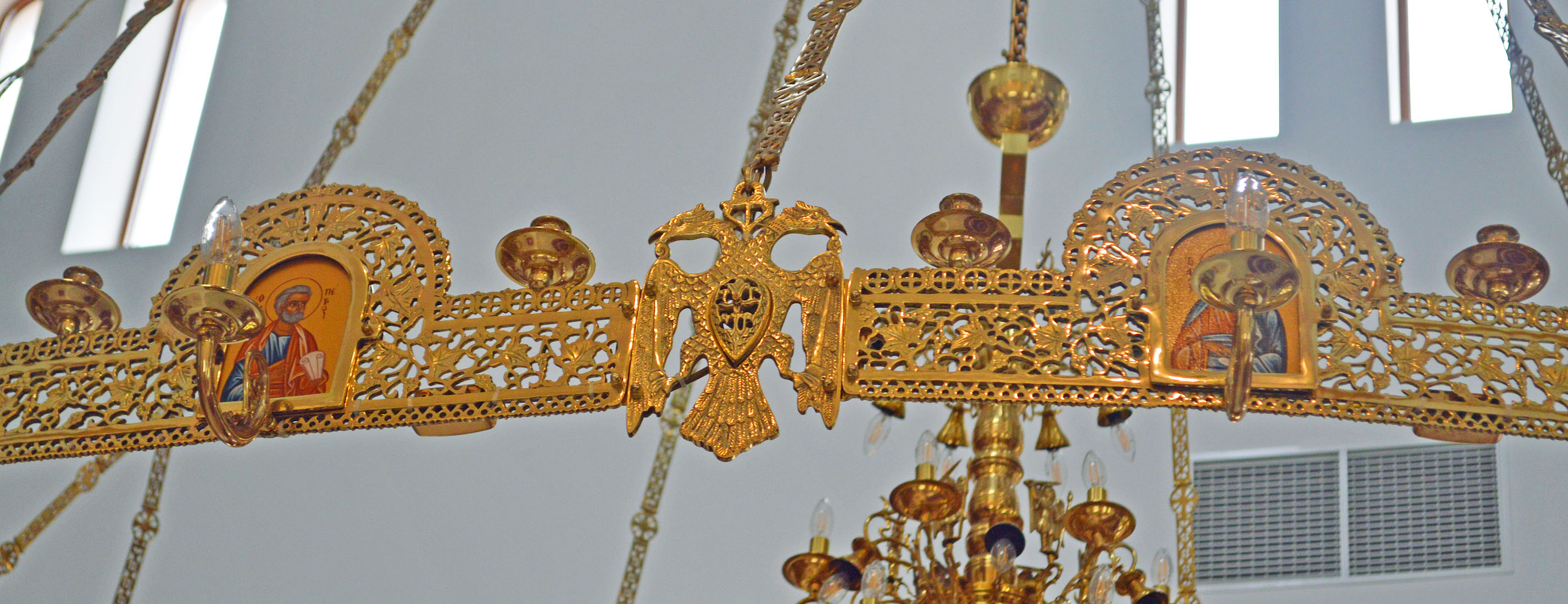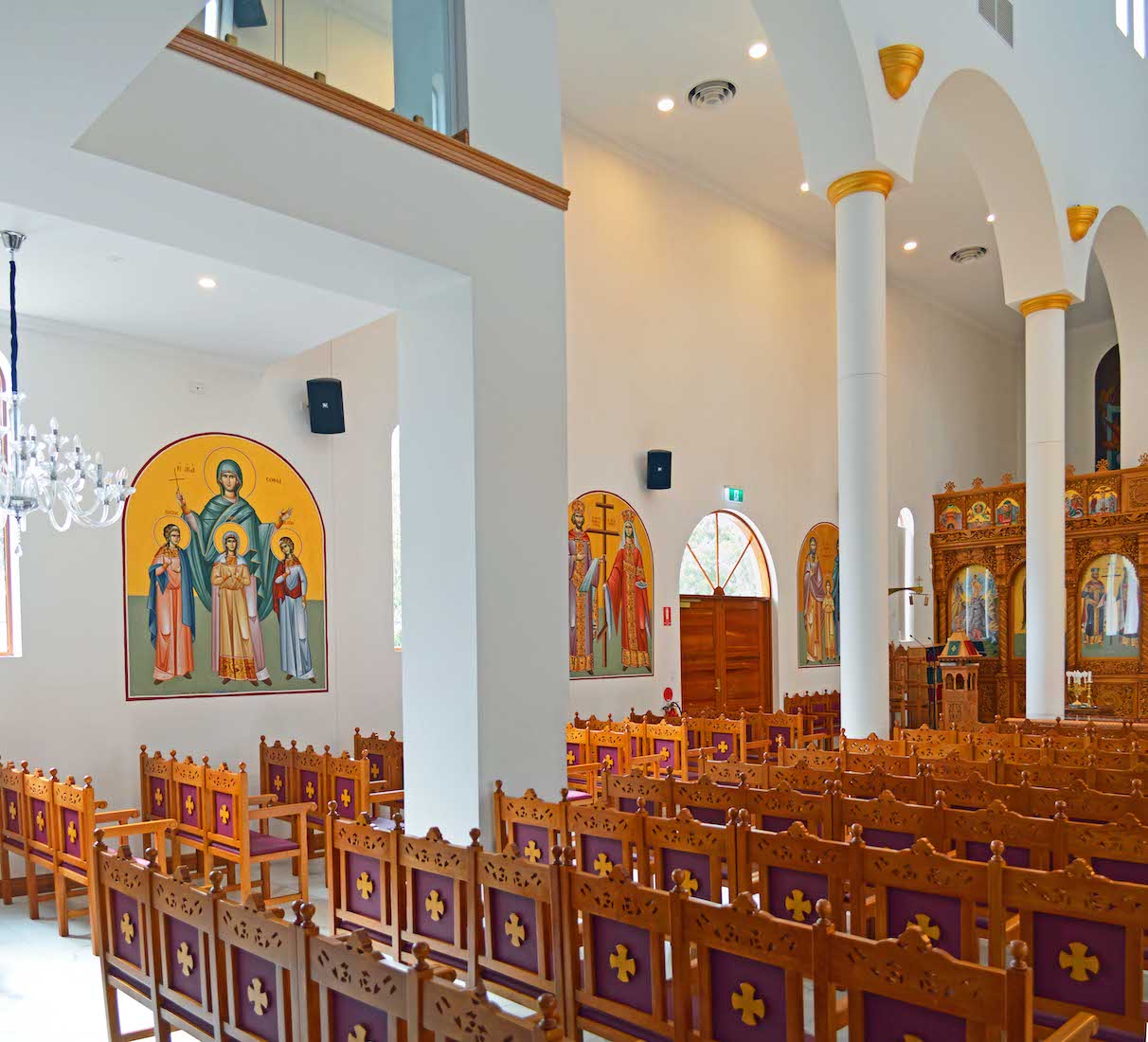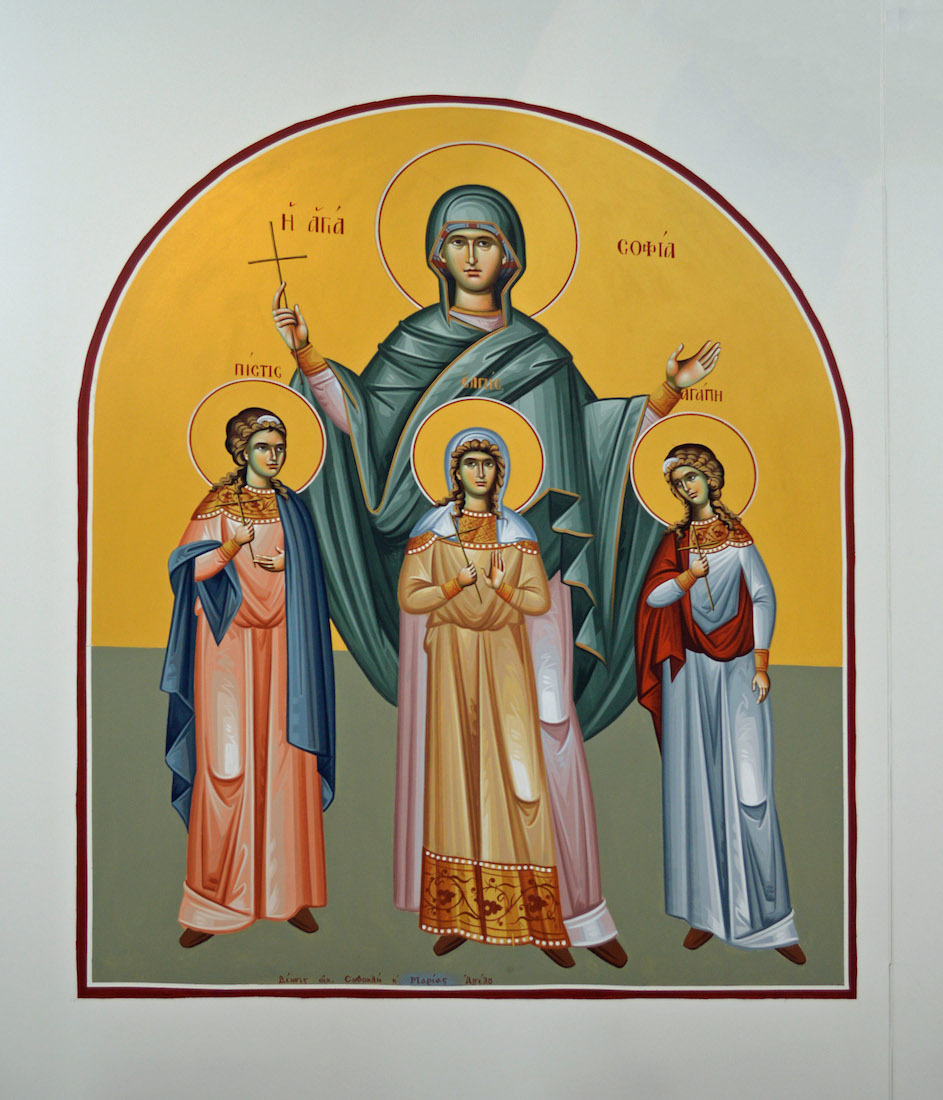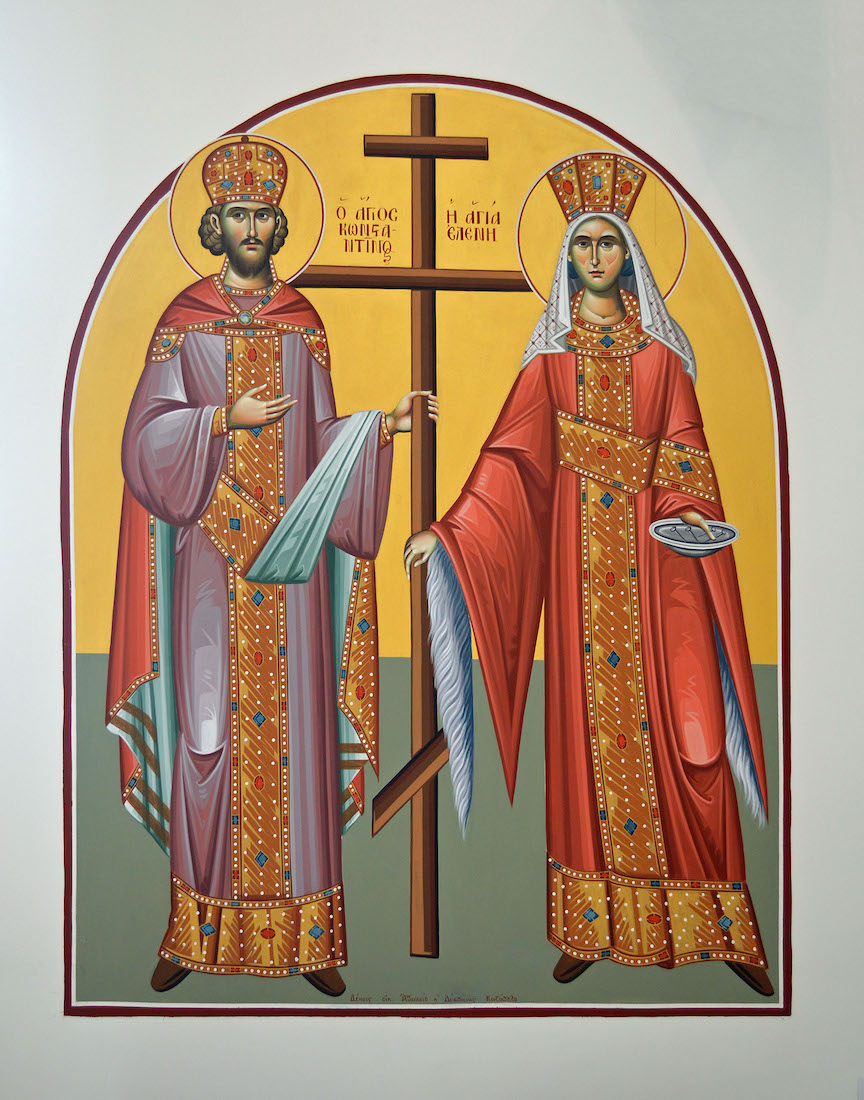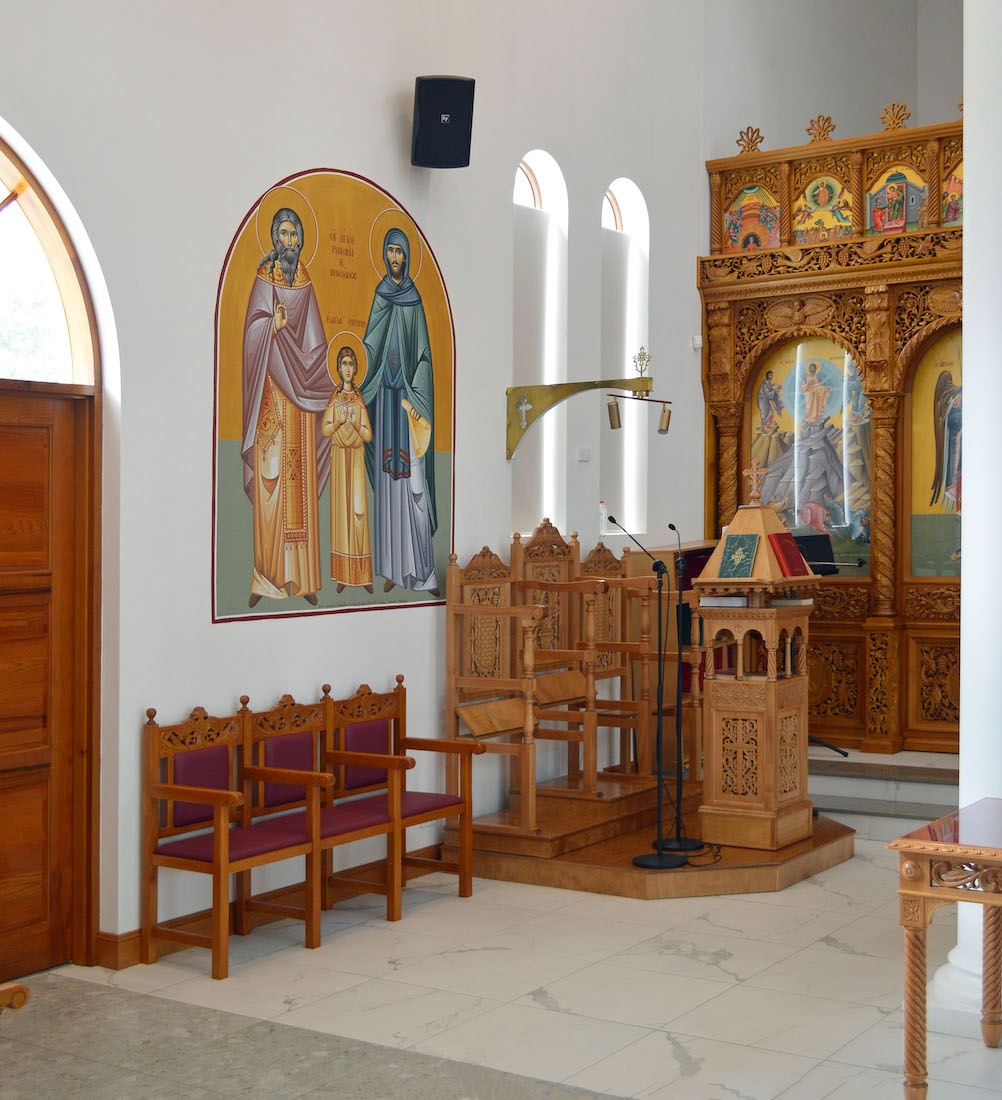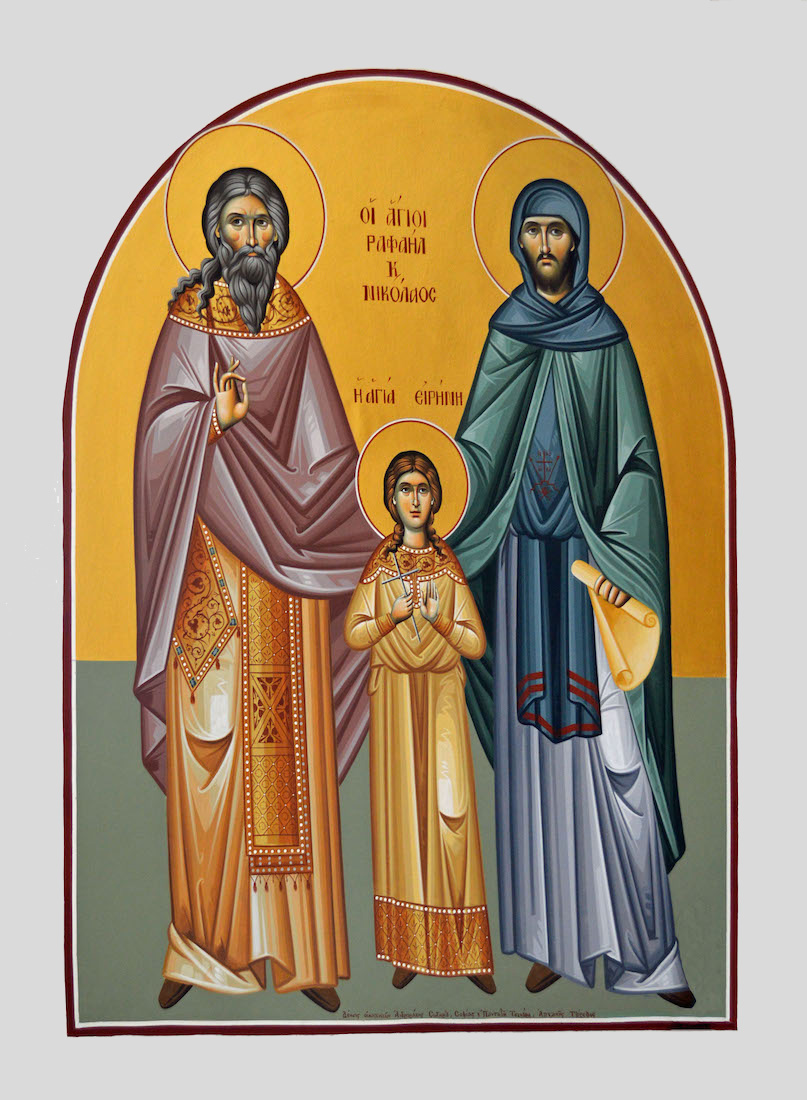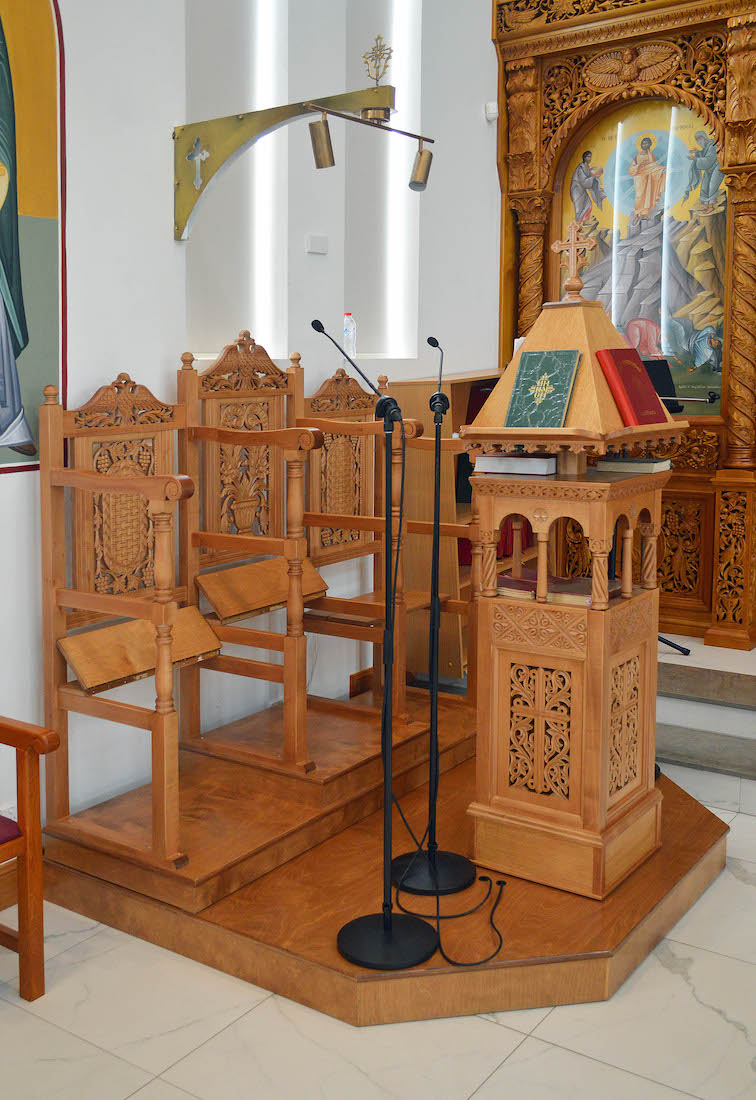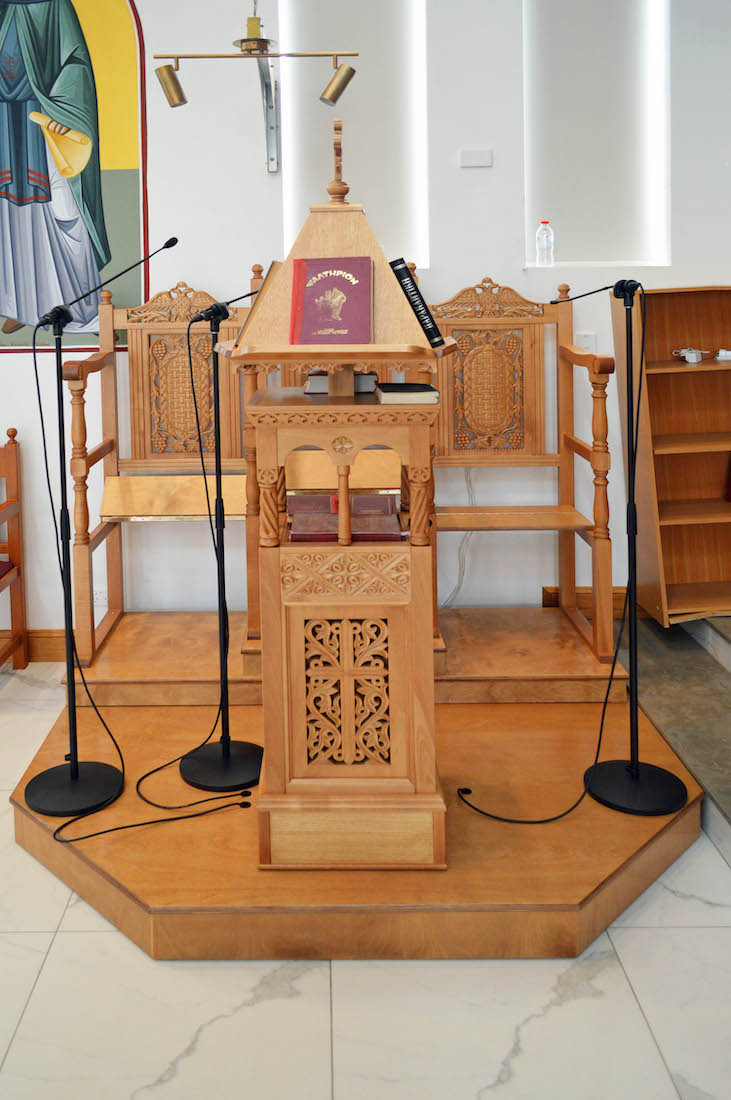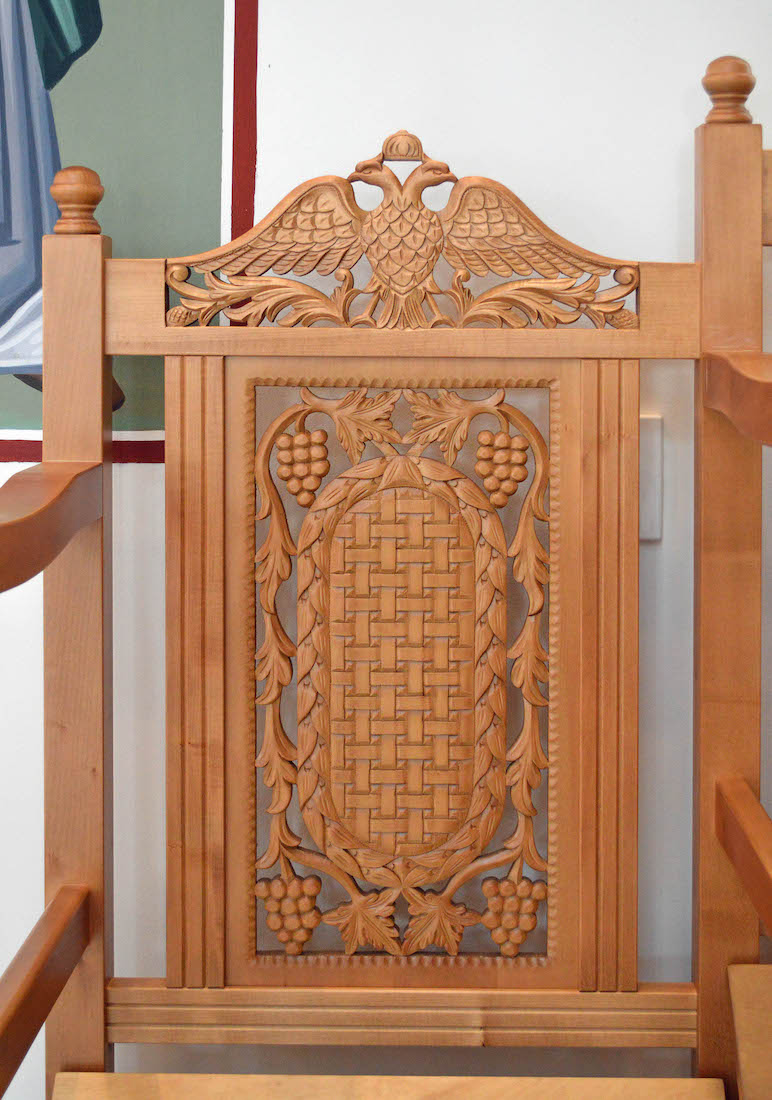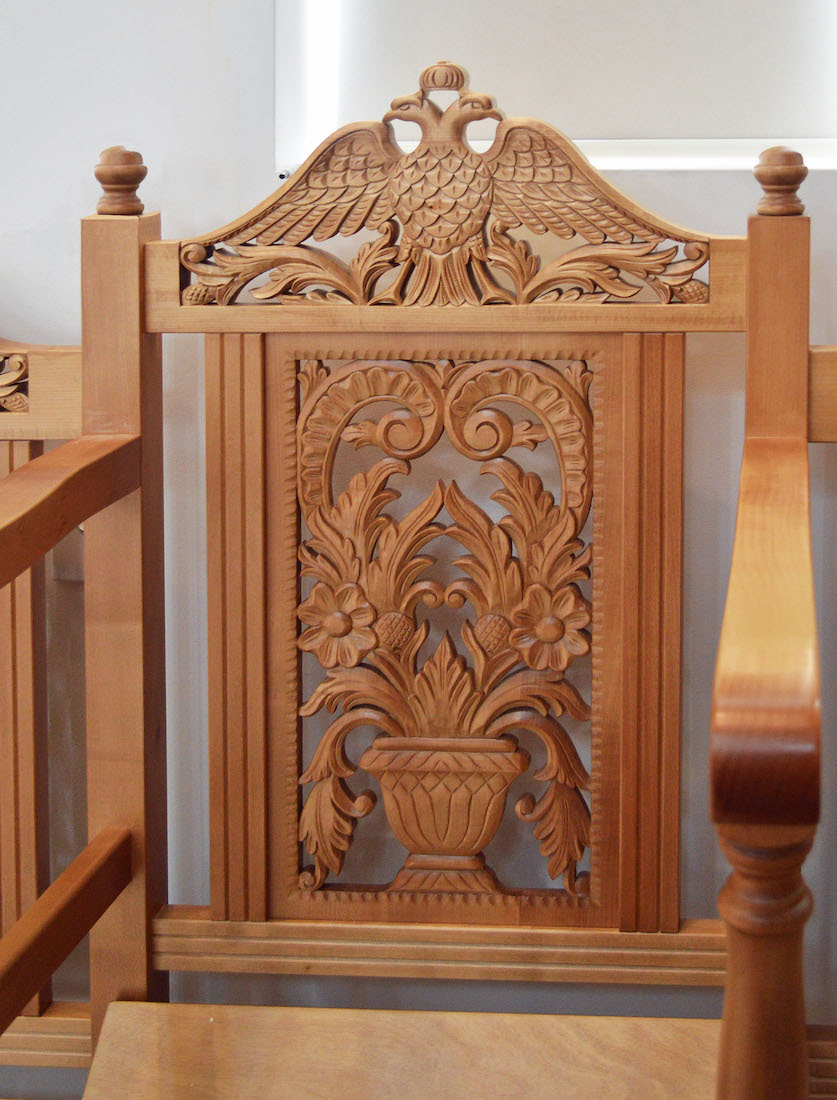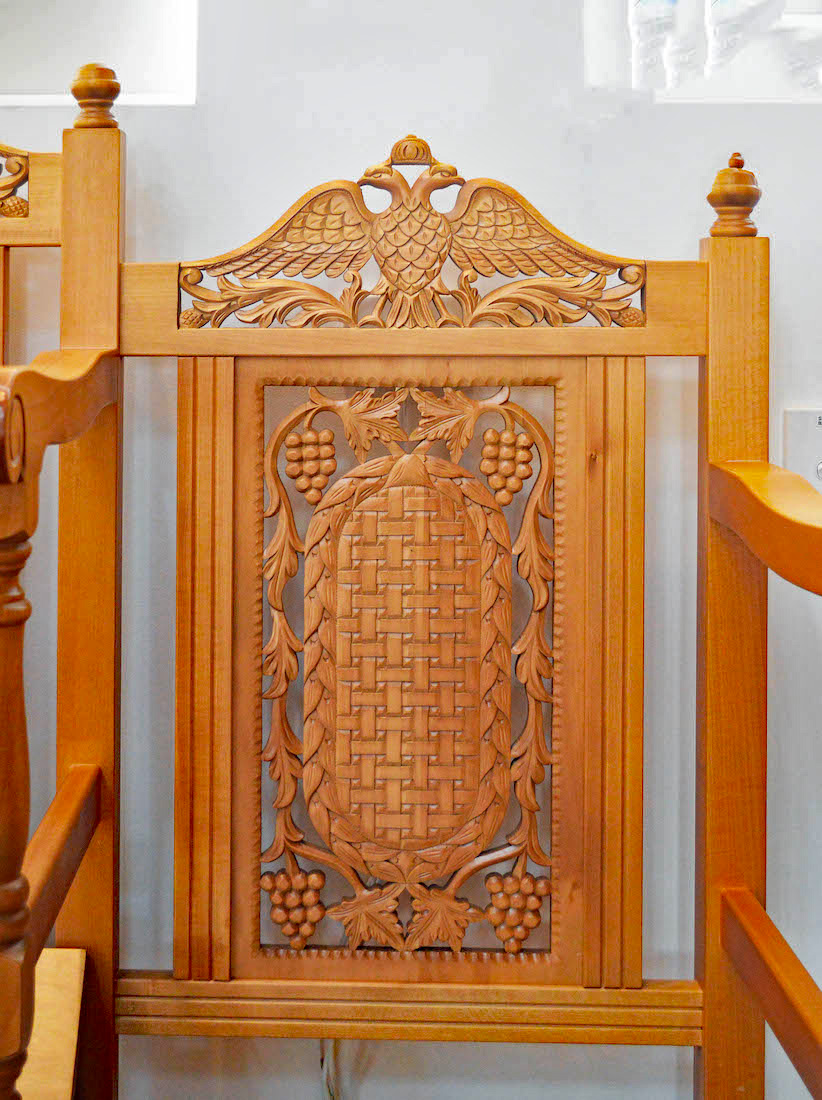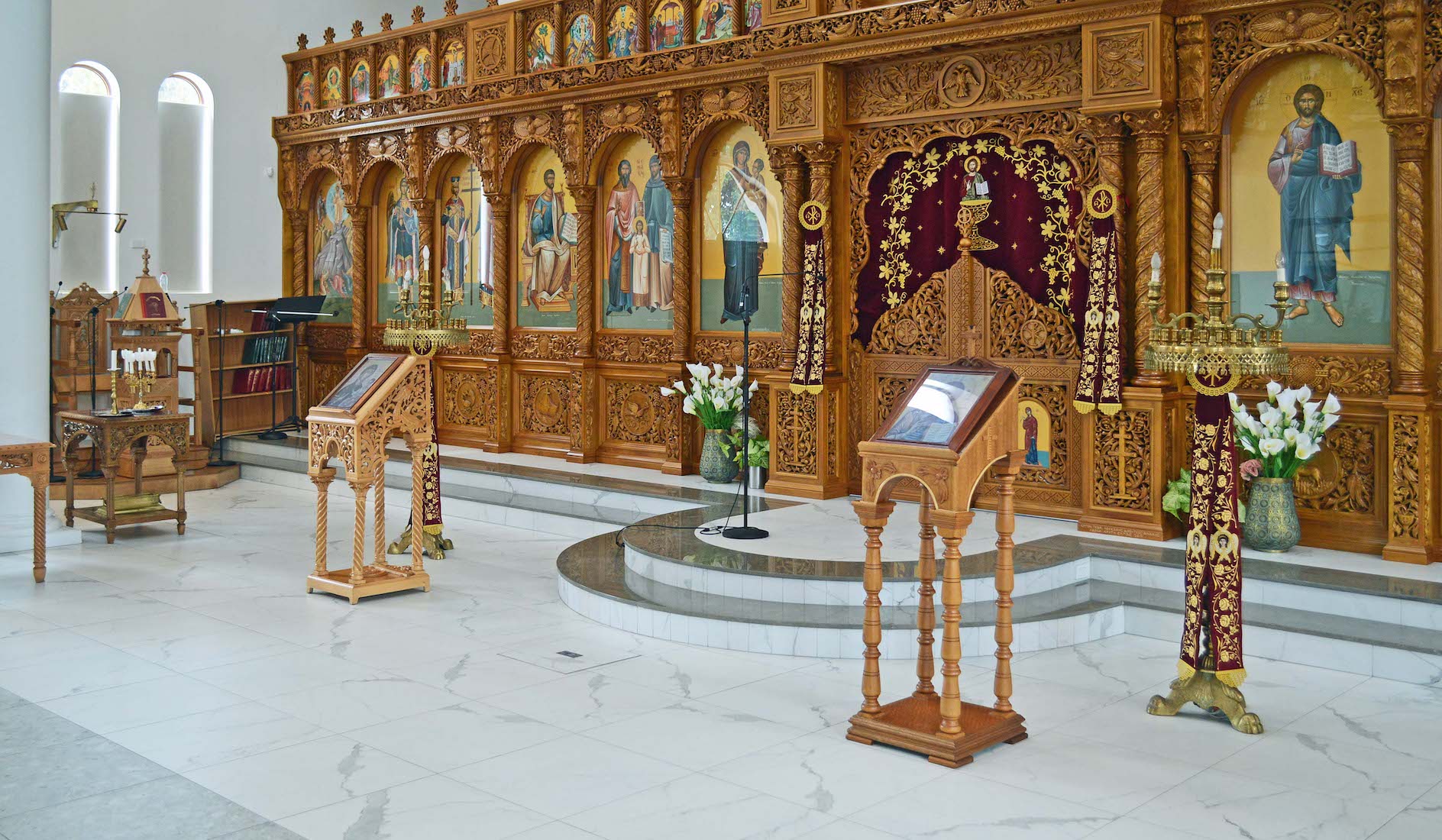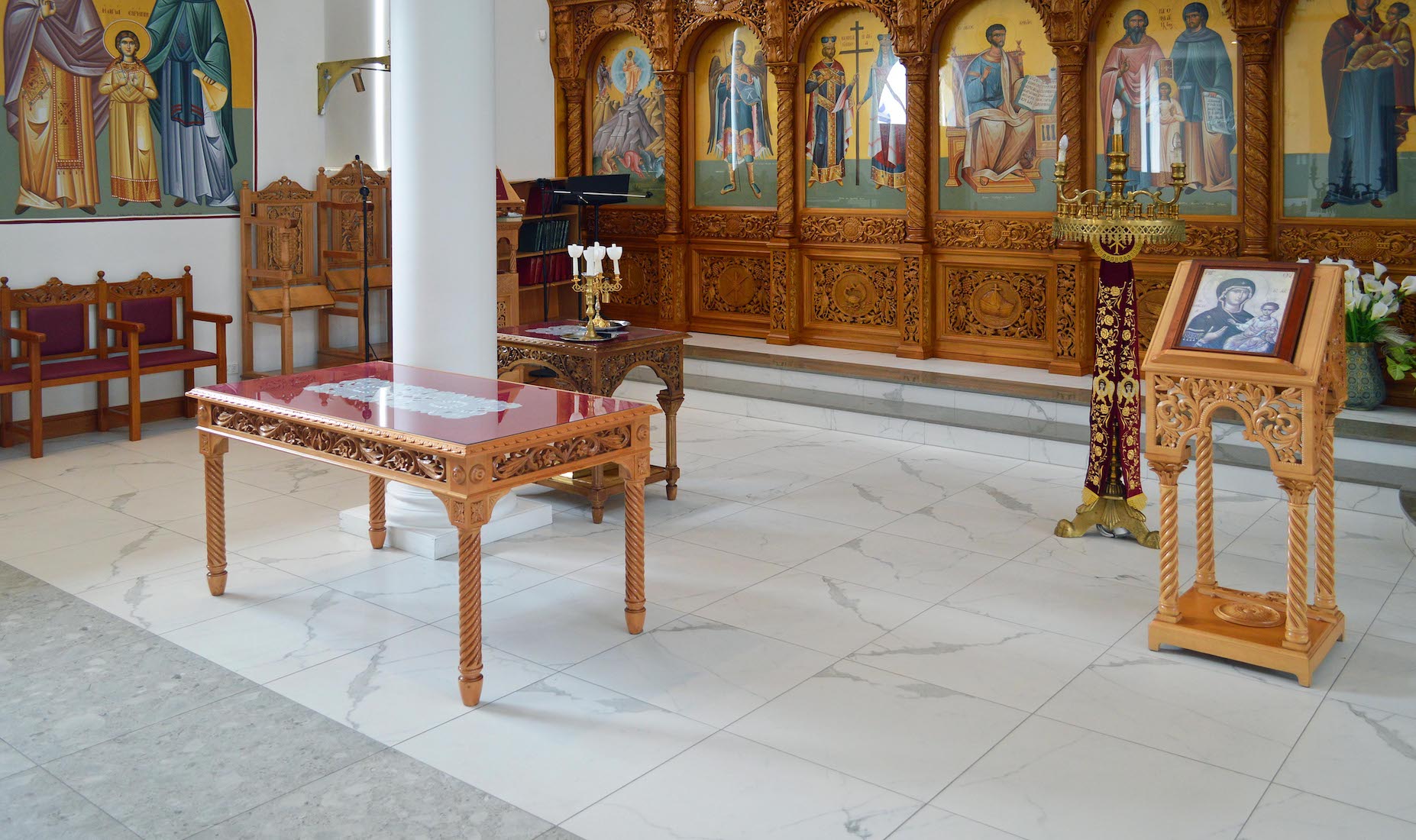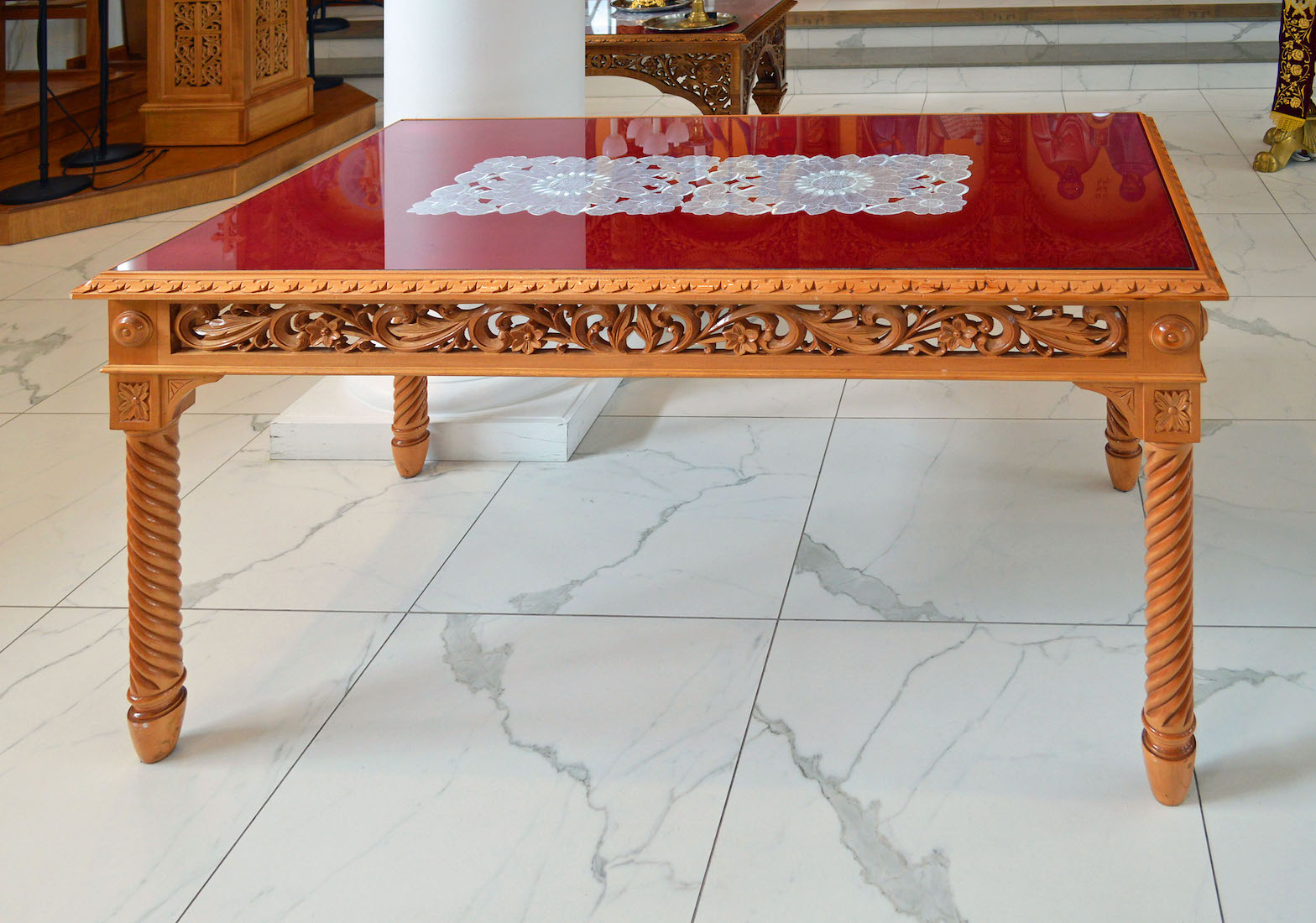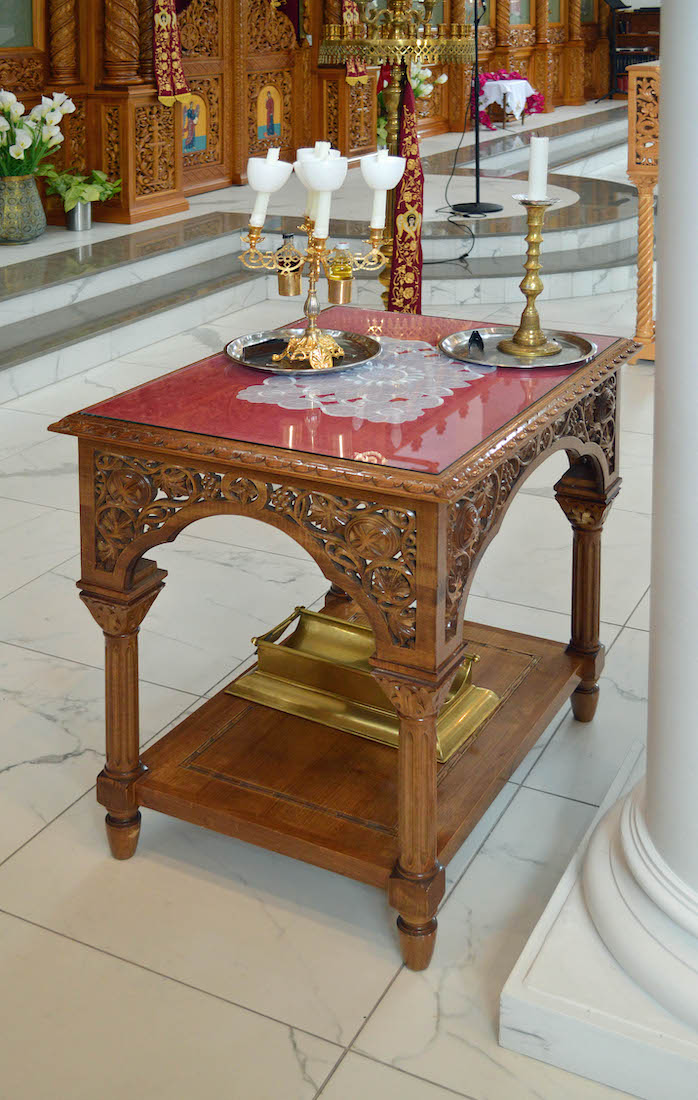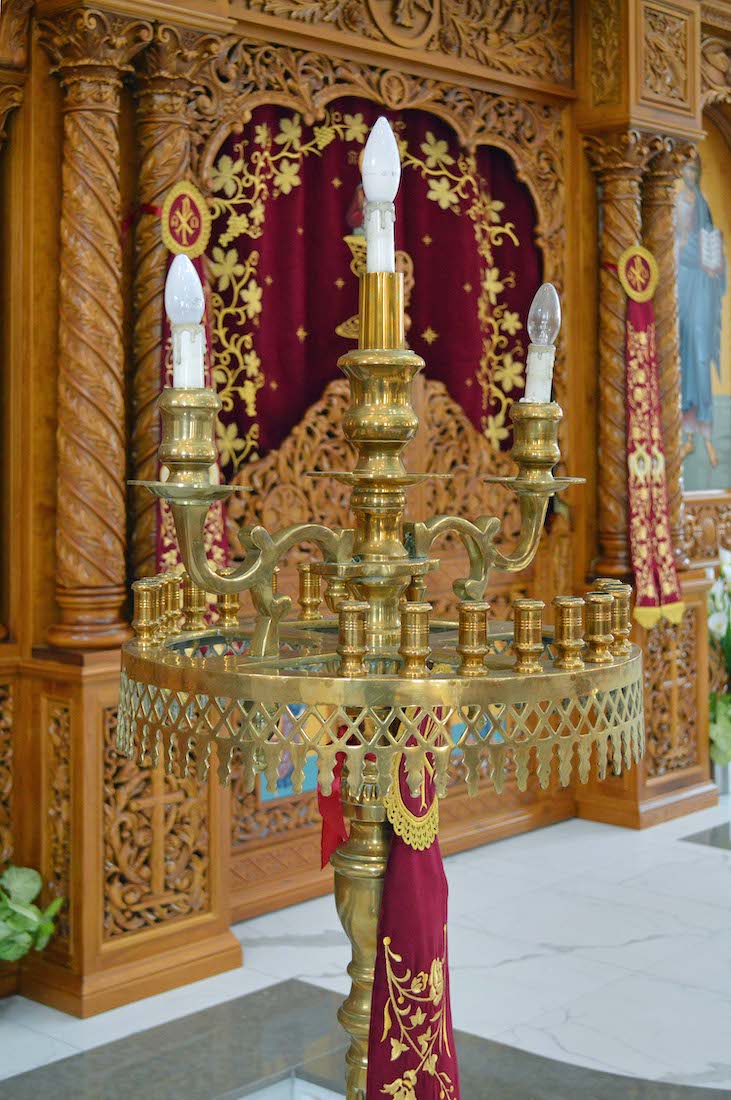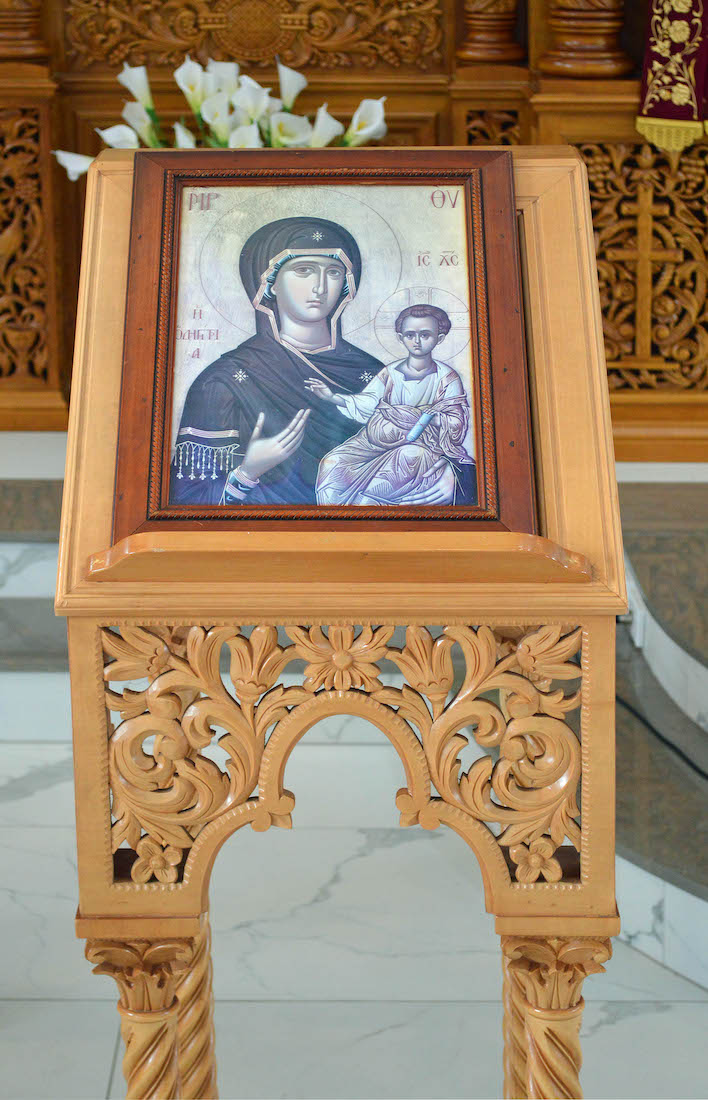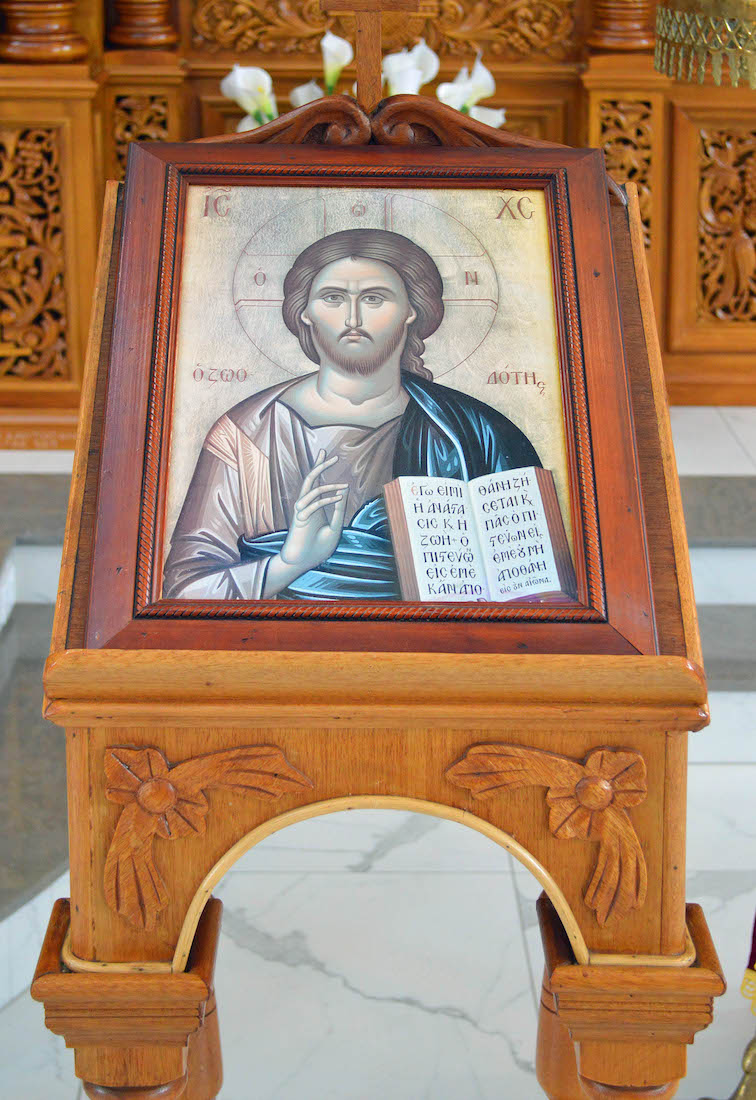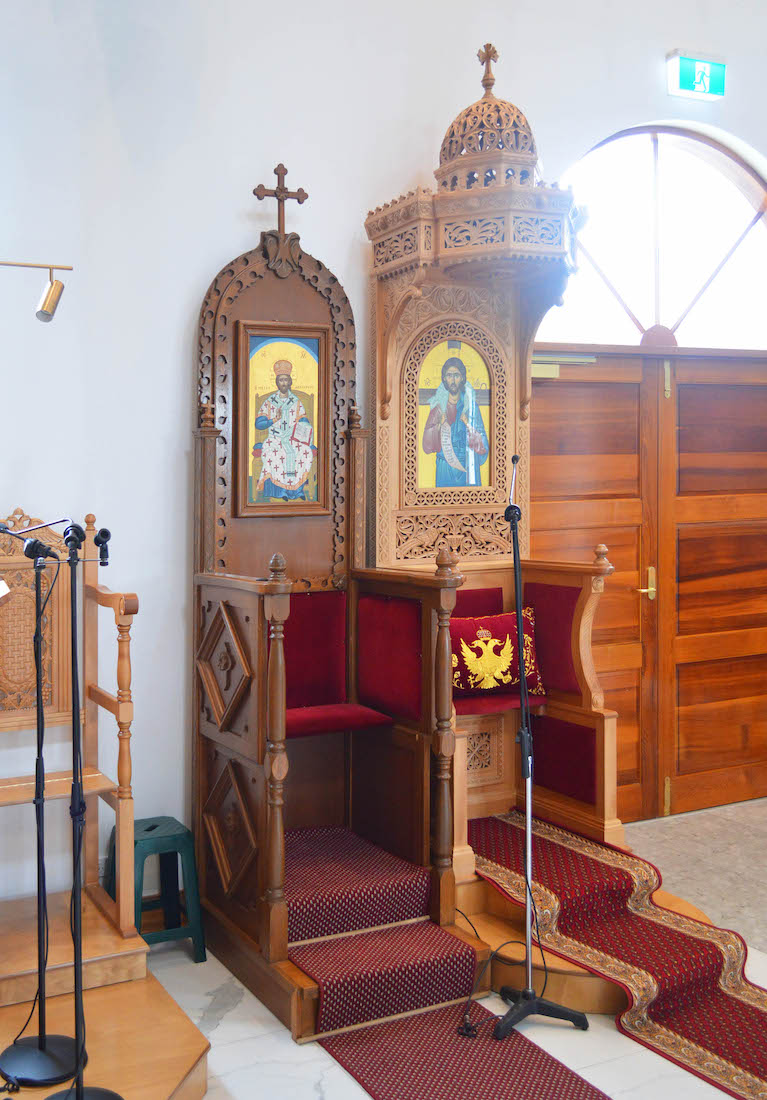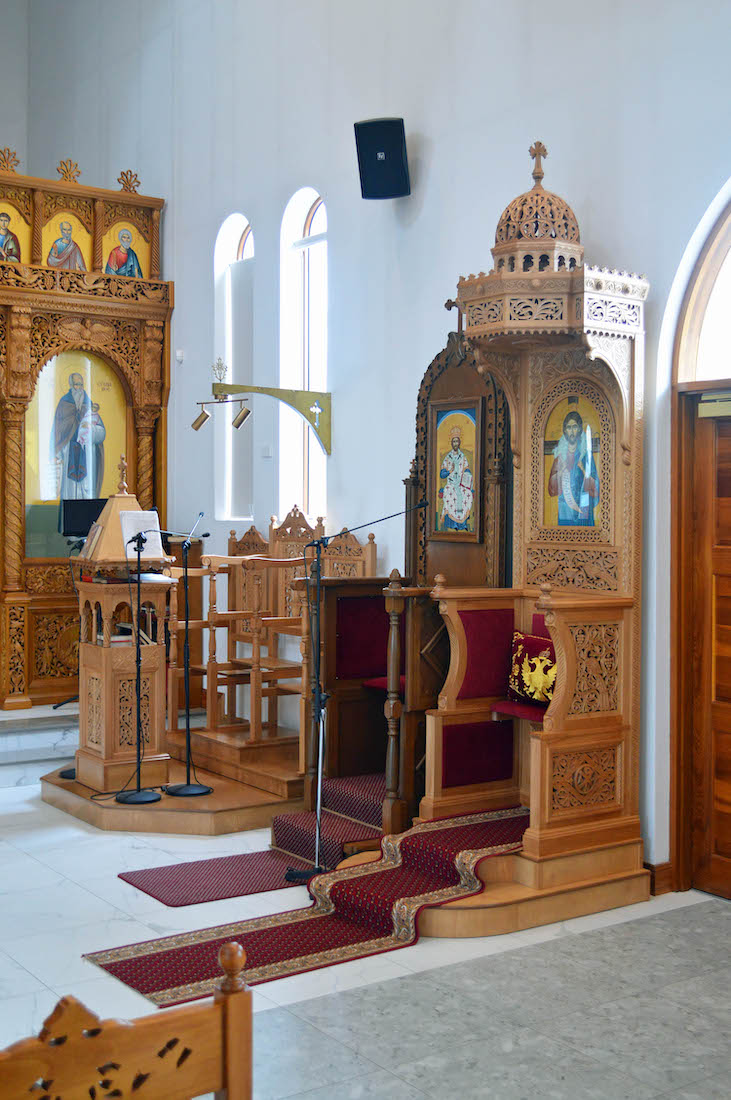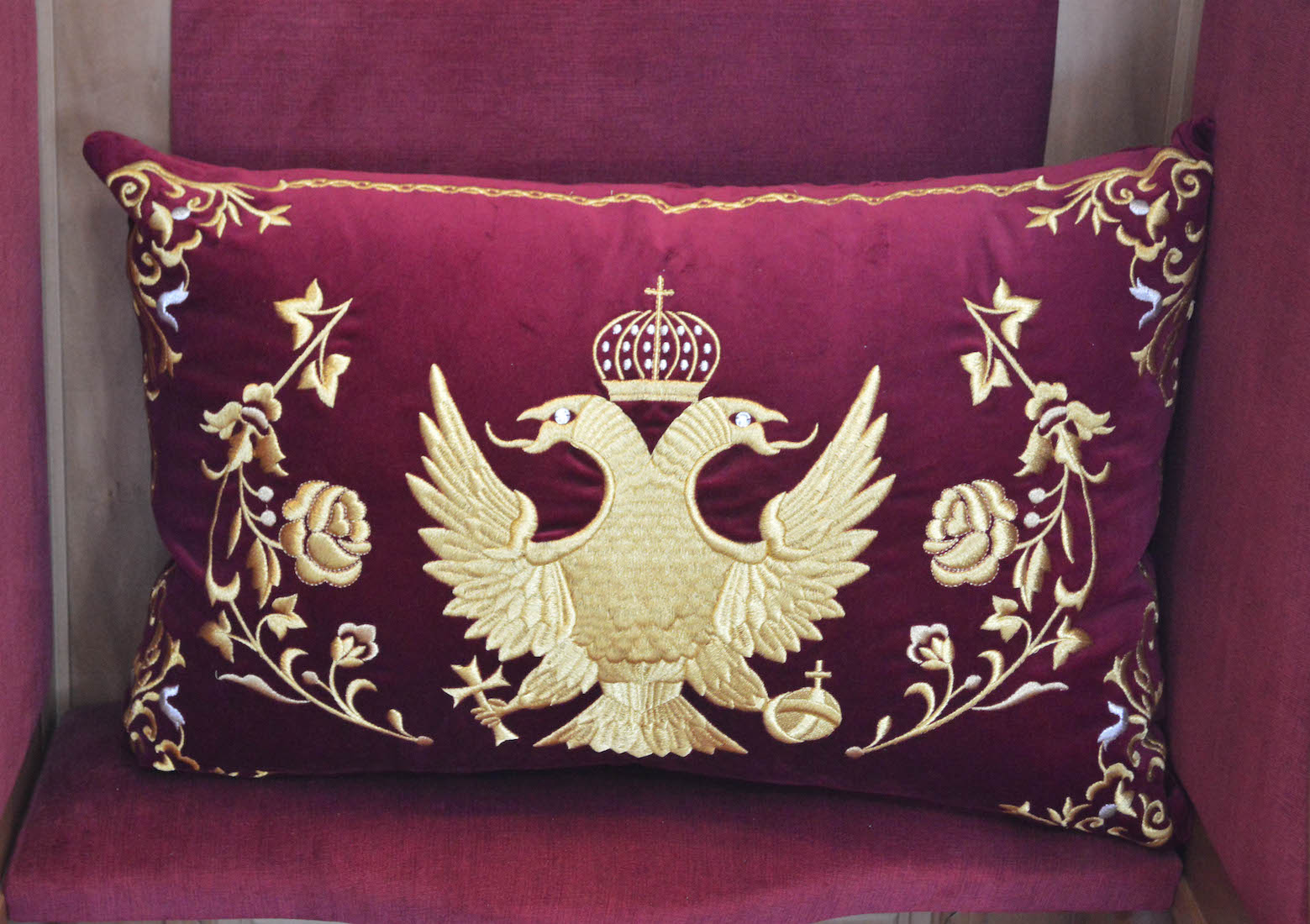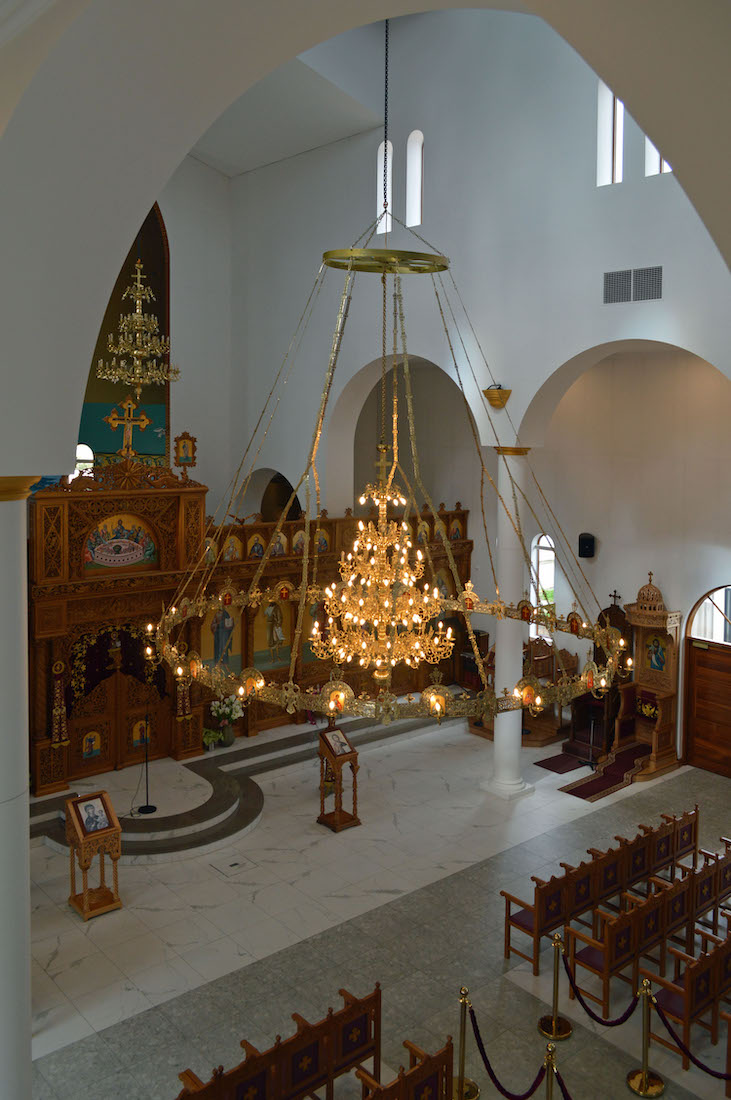
This Church seems to have many chandeliers, but at the front of the nave hangs THE chandelier. This is typical of the Orthodox Church. There is the allusion to Christ being the Light of the world as mentioned earlier. The chandelier can also be swung during the Church services. There is also the thought that there is a place for low lighting in a Church for creating a quietness of soul, or a state of inner attention. INDEX
22. SANCTUARY IMAGES
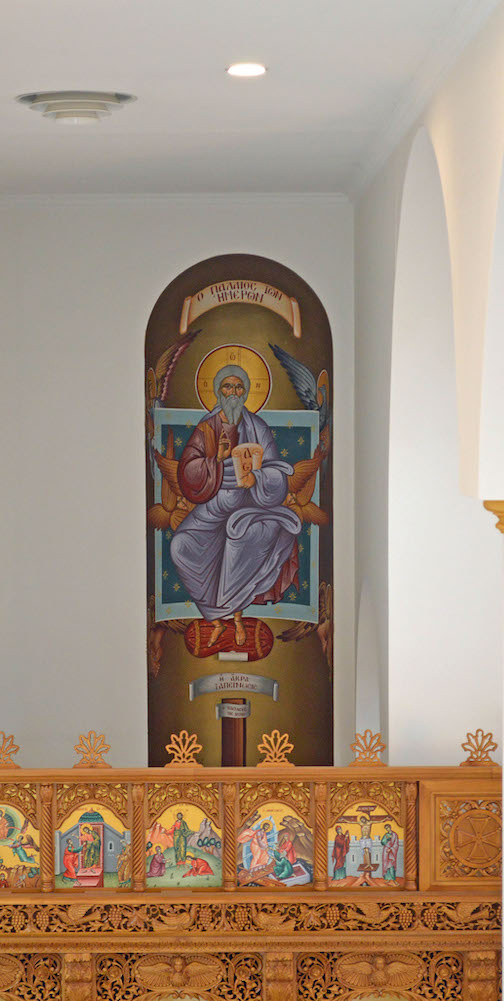
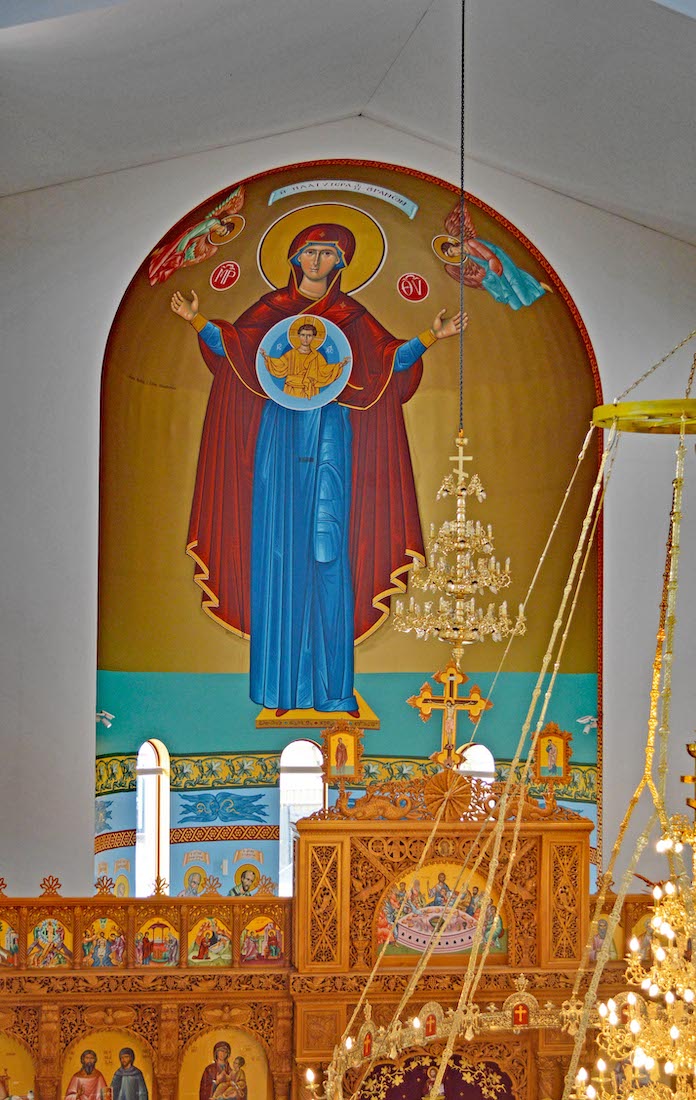
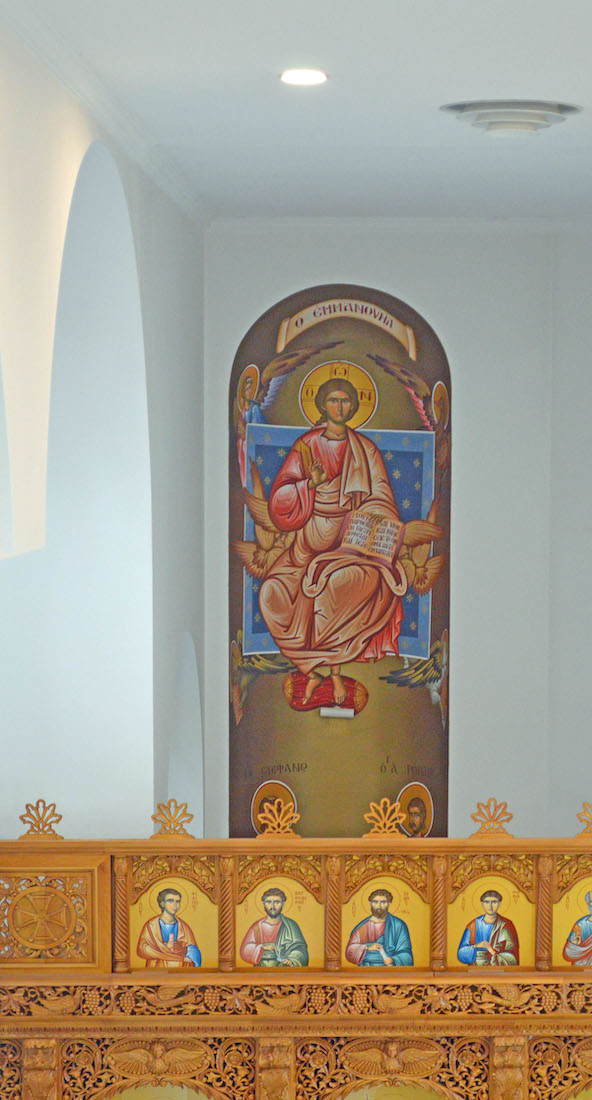
From the balcony we can see across the top of the icon screen to the upper portions of three images in the sanctuary (‘altar’).
23. NEAR THE SOUTH DOOR
Finally from the balcony we can look down to the South side of the nave where there stand a variety of chairs or thrones. There are paintings along the South nave wall too. We now descend the stairs and return to the narthex ... .
24. ENTERING THE NAVE
A favourite moment for me is standing at the back entrance to the nave and enjoying the sacred space before me. This Church does not disappoint! Before us is the Wall of Icons or ‘iconostasis’. Above is the Virgin Mary with the incredible hanging chandelier. And to the sides are rows of identical seats, all beautifully designed. As one old admonition says: ‘Let the Christian consider well when he enters the church that he is entering another heaven. That same majesty of God which is in heaven is also in his church, and on this account the Christian must enter with reverence and awe.’
25. INSIDE THE DOME
If we move down to the front of the nave aisle and look up, we see the impressive painted dome with Christ at the centre. The Four Evangelists, Matthew, Mark, Luke and John, appear in the corners. He is surrounded by flying angels and the Mother of God figure, and the dome windows are separated by various Old Testament prophets. Above each dome window is a Cross or a Chi-Rho image. • We notice too the many high plain ‘clerestory’ windows on the nave walls which fill the nave with light.
26. NAVE CHANDELIER
The central chandelier is magnificent! The outer ring is finely decorated and bears images of various icons and the double-headed eagle emblem of the Orthodox Church. In some Orthodox Churches the central chandelier is designed to rotate at some point of the service.
27. NORTH NAVE WALL
We look next at the side walls of the nave. Along the North wall, the windows are plain and not of interest, but interleaved are three large painted icons.
28. NORTH NAVE PAINTINGS
This painting shows Saint Sophia with the three virtues Faith, Hope and Charity (Love) below. For the Greeks, Sophia was the Goddess of Wisdom. In the theology of the Eastern Orthodox Church, Holy Wisdom is understood as the Divine Logos who became incarnate as Jesus. In the Divine Liturgy of the Orthodox Church, the exclamation Sophia! or in English Wisdom! will be proclaimed by the deacon or priest at certain moments, especially before the reading of scripture, to draw the congregation's attention to sacred teaching. There is a hagiographical tradition, dating to the late sixth century and illustrated here, of a Saint Sophia and her three daughters, Saints Faith, Hope and Charity. •• Now the painting on the right ... .Constantine was born 272 and he became Emperor of a portion of the Roman Empire in 306. In 312 Jesus Christ appeared to him in a dream and told Constantine about the cross and its significance. After the dream, he won a significant battle and rode to Rome with his victory banner inscribed with the Holy Cross and and the Name of Jesus Christ. He was declared to rule Rome West, while his brother-in-law, Licinius, was to rule Rome East. Under Constantine’s rule, Christianity really took root. In 325 he organized the First Council of Nicaea and he addressed the assembly personally. • Empress Helena was Constantine’s mother, and her story with Christianity really begins after Constantine had his victory. During this time, she traveled to the Holy Lands in Jerusalem where she is credited with finding the True Cross. Legend says that she was tipped off to the cross’s existence because she found the aromatic herb, basil, growing in the shape of a cross. Each year on September 14th, Orthodox Christians remember the cross on the Feast Day of the Elevation of the Cross by taking home some fresh basil.
29. NAVE NORTHEAST CORNER
A third wall painting lies just past the side door, just by a set of three readers’/ chanters’ chairs and stand. The chairs have interesting fold-back seats. • The third painting is once again the three saints we have seen before.
30. READER STAND AND CHAIRS
In each of the front corners of the nave are three interesting chairs and a reader stand. In the Orthodox Church, for most of the services, a person called the Reader stands at the front and reads what needs to be read during the service. The services are compiled from at least three different books depending on the day of the year and how the church calendar cycles work out. Basically, there are a lot of books and they are all used during every service. So churches have dealt with this preponderance of books in various ways, but one of the more striking ones is a rotating book stand – the reader stand. It is basically a narrow bookshelf with a rotating book rest on top. Before the service starts, all the needed books are opened at the right place and laid out, and then the top is rotated to get to the required book of the moment. The system works well and looks much nicer than metal music stands loaded up with 3-ring binders.
31. READERS’ CHAIRS
The readers’ chairs are beautifully designed with the main back panels showing a potted plant and woven trays surrounded by vine foliage. At the top of each is the double-headed eagle emblem of the Orthodox Church.
32. FRONT NAVE
We look next at the space at the front of the nave, between the seating and the wall of icons.
33. FRONT NAVE FURNISHINGS
Here there are various tables, lamp stands and icons with special supports.
34. FRONT TABLE
There are two ornate tables in this area – a large table at front, and a smaller table behind. This large table has no official place in the furnishings of an Orthodox Church, but is available for any need at hand.
35. SMALL FRONT TABLE AND CANDLESTAND
The smaller table is obviously used, at least sometimes, for supporting candles, and nearby there is a proper candle-stand. It is clear that candles have an important place in Orthodox tradition. The candle represents the Light of Christ, the flame of faith. Orthodox Christians tend to believe that the light at a church best maintains its symbolism and helps the soul to be enlightened when it is natural: that is, burning beeswax candles and oil lamps rather than the more artificial light that comes from electricity. I suspect this conflicts with practice in a modern church like this!
36. FRAMED ICONS
At the front of the nave are two displayed icons. At right is Christ Pantokrator (Christ Almighty, or Christ All-Powerful). This was one of the first images of Christ developed in the Early Christian Church and remains a central icon of the Eastern Orthodox Church. Jesus holds the text, ‘I am the Way, ...’ (John 14:6)• At left is Mary, ‘the Theotokus’ (Greek for ‘Mother of God’, literally ‘God-Bearer’). The tradition of the Orthodox Church maintains that the first iconographer was the evangelist Luke, and that the first icon he painted under divine inspiration was of the Mother of God holding the Christ-child. This icon is sometimes called a Hodegetria (She who shows the way), with Mary pointing to Jesus as the source of salvation for mankind. •• The icons which appear here may vary on certain Feast Days.
37. SOUTH READER STAND
In the Southeast corner of the nave is an identical reader stand and chairs as we have already seen.
38. BISHOP’S THRONE
Just along from the readers’ stand is the bishop’s throne from which the bishop presides as a living icon of Christ among his people. Even in the bishop’s absence, the throne reminds all that the parish is not an isolated entity but is part of a diocese which the bishop heads. The adjacent throne might be for the bishop’s assistant, or for some important visitor.
39. CUSHION WITH ORTHODOX EMBLEM
The cushion of the bishop’s throne displays once again the double-headed eagle of the Orthodox Church
40. CHRIST ICONS
There are two icons of Christ displayed here. • At left is an icon of Christ as The Great High Priest. • At right Jesus is portrayed as The Good Shepherd.


